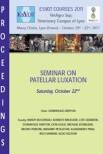Objective
Evaluate synovial fluid cytology, total protein concentration and viscosity after intra-articular administration of combined pentosan polysulfate and glucosamine in horses.
Design
Ten adult Standardbred horses had each carpal joint (n = 20) randomly assigned to one of two treatments: control (5 mL saline) or treated (pentosan polysulfate and glucosamine). All horses received an intra-articular injection every 7 days for 3 weeks and synovial fluid samples were collected on days 1 (baseline), 2, 3, 7, 8, 9, 14, 15, 16 and 21. Synovial fluid variables measured included total protein concentration, total nucleated cell count, red blood cell count, the neutrophil, lymphocyte, mononuclear cell and eosinophil percentages, and viscosity.
Results
Following injection, the total nucleated cell count increased in the synovial fluid samples from both groups. Values were significantly higher in treated joints on days 2, 3, 15 and 16. Red blood cell counts were low and no differences were seen between treated and control joints. Total protein concentrations and neutrophil percentages increased in both groups after injection, but decreased towards normal ranges within 7 days. Total protein concentration was significantly higher in treated joints on days 1, 3, 8, 9 and 15. Percentages of neutrophils were higher in treated joints on day 2, but significantly lower on days 8 and 15. Viscosity was significantly higher in treated joints on day 2 only.
Conclusions
Intra-articular administration of combined pentosan polysulfate and glucosamine causes a mild inflammatory synovitis that is not substantially different to that elicited by injection of a similar volume of saline and so we conclude that these drugs are safe to use in the horse.









